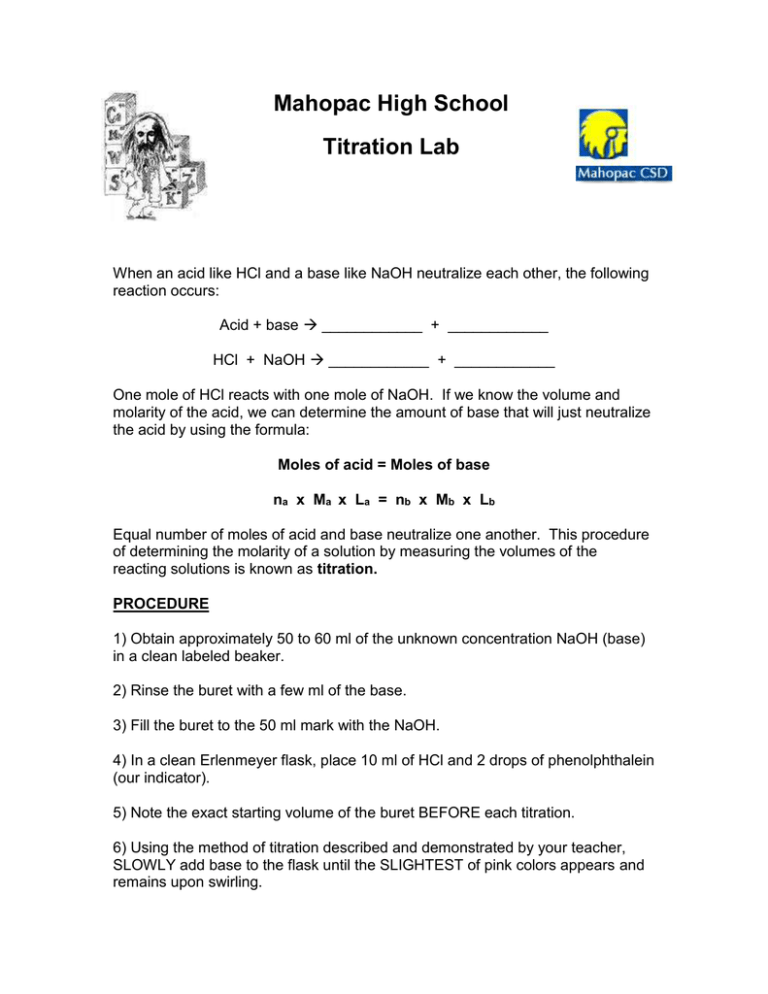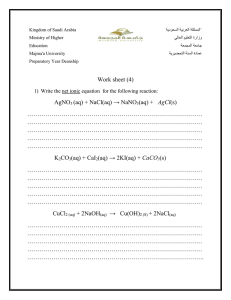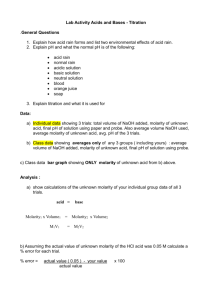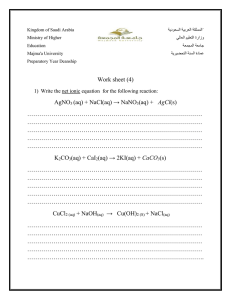Titration
advertisement

Mahopac High School Titration Lab When an acid like HCl and a base like NaOH neutralize each other, the following reaction occurs: Acid + base ____________ + ____________ HCl + NaOH ____________ + ____________ One mole of HCl reacts with one mole of NaOH. If we know the volume and molarity of the acid, we can determine the amount of base that will just neutralize the acid by using the formula: Moles of acid = Moles of base na x Ma x La = nb x Mb x Lb Equal number of moles of acid and base neutralize one another. This procedure of determining the molarity of a solution by measuring the volumes of the reacting solutions is known as titration. PROCEDURE 1) Obtain approximately 50 to 60 ml of the unknown concentration NaOH (base) in a clean labeled beaker. 2) Rinse the buret with a few ml of the base. 3) Fill the buret to the 50 ml mark with the NaOH. 4) In a clean Erlenmeyer flask, place 10 ml of HCl and 2 drops of phenolphthalein (our indicator). 5) Note the exact starting volume of the buret BEFORE each titration. 6) Using the method of titration described and demonstrated by your teacher, SLOWLY add base to the flask until the SLIGHTEST of pink colors appears and remains upon swirling. 7) Record the amount of base used to reach the endpoint of neutralization. 8) Using the titration formula, calculate the molarity of the unknown base. 9) Repeat this procedure for 2 more trials, and average the values obtained for the molarity of the base. 10) Check your results with your teacher BEFORE proceeding to the next part. Expt 1 M acid ml acid M base 2 3 4 Average Molarity of the base = ____________________ ml base Part 2 – Determining the Molarity of Unknown Acids Now that we know the molarity of the NaOH at your desk, we can use this information to determine the molarity of unknown acids. Just as a coincidence, there are unknown acids X and Y for us to test. Calculate the molarity (concentration) of these acids using the titration procedure from part 1. Again you will be using 10 ml of the acid in the erlenmeyer and 2 drops of phenolphthalein. Expt 1 M acid ml acid M base ml base UNK X 2 UNK X Average Molarity of unknown acid X = ____________ Expt 1 M acid ml acid M base UNK Y 2 UNK Y Average Molarity of unknown acid Y = ____________ ml base Questions: 1) If only litmus paper were available, how could you know when you were at the endpoint of the titration? 2) If no color change occurred upon titrating the base into the acid, what might have gone wrong? 3) If an air bubble below the stopcock was not noticed, how would this have affected your results? 4) If the flask was not totally dry when you titrated, what would be the effect on your data?





